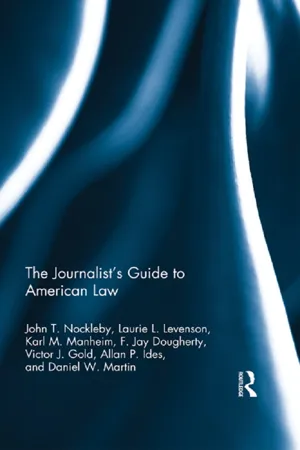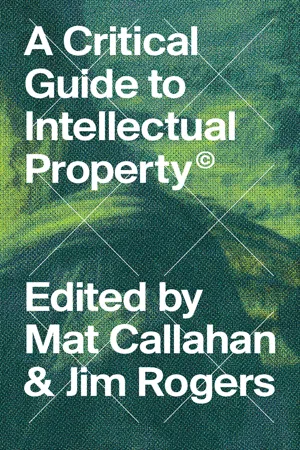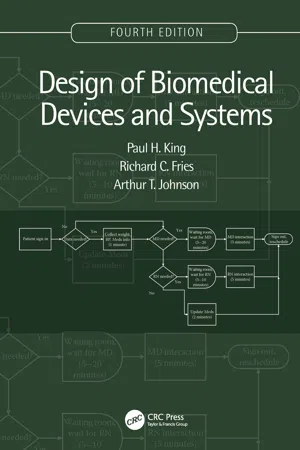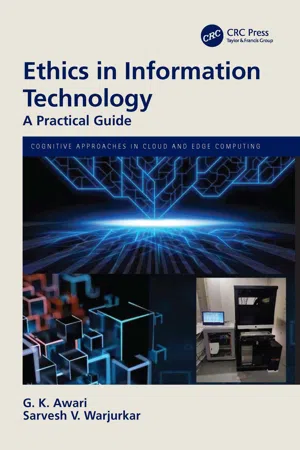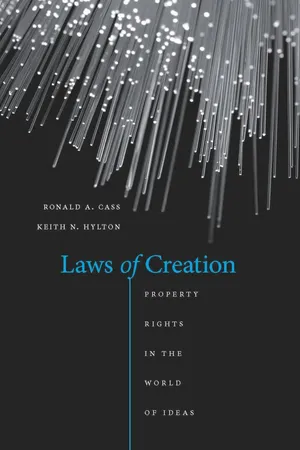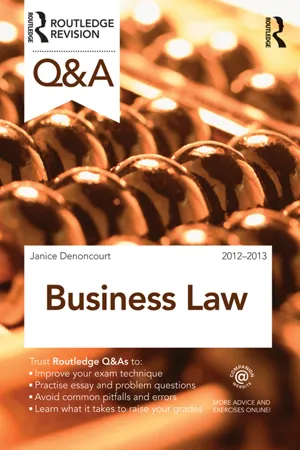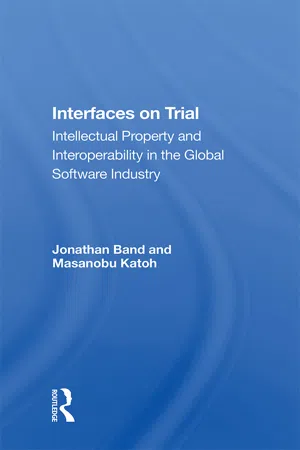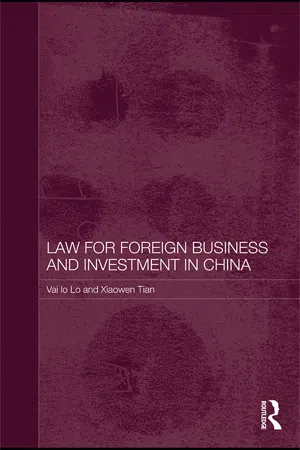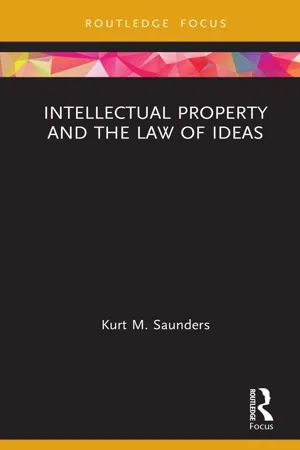Law
Intellectual Law
Intellectual law refers to the legal framework that governs the protection of intellectual property, including copyrights, patents, trademarks, and trade secrets. It encompasses laws and regulations that safeguard the rights of creators and innovators, ensuring that their original works and inventions are not unlawfully used or exploited by others.
Written by Perlego with AI-assistance
Related key terms
11 Key excerpts on "Intellectual Law"
- eBook - ePub
- John Nockleby, John T. Nockleby(Authors)
- 2013(Publication Date)
- Routledge(Publisher)
7Intellectual PropertyF. Jay DoughertyProfessor of Law (Copyright Law and Trademark Law), Loyola Law SchoolKarl M. ManheimProfessor of Law (Patent Law), Loyola Law SchoolThe term intellectual property is a relatively modern phrase, usually referring to several rather different bodies of law, namely, copyright, trademark, and patent law. Various other related business torts, such as trade secret law or unfair competition, might also be considered within this rubric. However, this chapter will focus on the three areas of law at the core of what we call intellectual property—copyright, trademark, and patent law.Copyright provides a set of exclusive rights in original works of expressive authorship. Patents also provide exclusive rights for new and useful products and processes. Trademark law applies primarily to distinctive words, symbols, and other devices that indicate the source of goods or services, and protects them from use by competitors of confusingly similar marks. This chapter will consider each of those bodies of law in somewhat more detail.Normally, when one thinks of property, tangible objects come to mind, either real property (land) or personal property (other physical assets). By contrast, intellectual property deals with intangibles—creations of the mind. These are often considered forms of property because of the rules that protect ownership and use of the creations. As with ownership of real property, these rules provide a legal basis to exclude others from certain conduct or uses of the subject matter. Thus, it is not unusual for an injunction, that is, a court order to do something or to refrain from doing something, to be awarded where an infringement, or even merely a likely infringement, is found.It is not uncommon for nonexperts, including journalists, to confuse these different bodies of law. For example, one sees a news story about a legal dispute over the title of a film or the name of a pop band.1 - eBook - ePub
- Mat Callahan, Jim Rogers, Mat Callahan, Jim Rogers(Authors)
- 2017(Publication Date)
- Zed Books(Publisher)
This chapter is structured as follows. First, it provides a brief overview of the characteristics of intellectual property, highlighting the protection–dissemination paradox that lies at its heart. The second section outlines the politics that drive IP policy. The third presents an argument for analyzing IP laws as public policy, through an empirically based economic lens that emphasizes IP’s role in promoting a socially optimal level of knowledge and cultural creation. It then applies this framework to the case of Aaron Swartz’s prosecution for hacking the JSTOR academic journal article database at MIT as an example. The chapter then offers some guidelines for how we can cut through the legal thicket and moral arguments, and engage in a productive dialogue on how to reform the laws that govern something so fundamental as knowledge itself. It concludes with some final thoughts.Most of this chapter is focused on the US intellectual property debate because it is the driving force behind global IP reform. While all countries face similar issues, their experiences, and their IP politics, are all somewhat different. That said, the principles developed in this chapter are generally applicable.What is intellectual property?Intellectual property is the currently dominant form of regulation governing the creation and use of knowledge. While it originated in Europe, IP law has spread to become the dominant way that we regulate knowledge worldwide. Roughly speaking, the three main categories of IP are copyright (creative works such as books, music and film, but also computer software and things like hull designs), patents (industrial processes, such as drug formulas and Amazon’s one-click shopping) and trademarks (identifying marks, such as McDonald’s Golden Arches, but also the phrase “Let’s get ready to rumble”).4 Intellectual property is designed to commodify abstract works so that they can be bought and sold in a market economy.Intellectual property is a state-created form of protection that provides IP owners with limited rights to determine how this knowledge may be used, including the right to buy or sell the IP. It commodifies knowledge. These rights, or privileges, allow for things such as music and drug formulas to be bought and sold, and limit the ability of others to use, or copy, these otherwise abstract ideas. In a market economy, the concern is that because it often takes a great deal of time and resources to come up with an idea, but it is relatively trivial to copy it, without some form of protection, there will be a suboptimal level of creation and invention. Consequently, intellectual property is designed to provide creators with certain rights that will allow them (potentially) to profit from their creation. - eBook - ePub
Creativity and Innovation in Business and Beyond
Social Science Perspectives and Policy Implications
- Leon Mann, Janet Chan(Authors)
- 2011(Publication Date)
- Routledge(Publisher)
Rather, it is only those intellectual products for which there is a specific legal regime of protection, and which satisfy the ingenuity threshold requirement of the regime, that obtain the benefit of the grant of exclusive rights. In essence, only those intellectual products that are either aesthetic or functional in nature are protected. Typical examples of aesthetic intellectual products protected by intellectual property law are works of art, literature and music, and the shapes of consumer goods. Copyright law is the regime by which protection is provided to works of art, literature and music, while design law protects the shapes of consumer goods. Typical examples of functional intellectual products protected by intellectual property law are scientific and technological inventions and trademarks (words or symbols that act as indicators of origin of product). Patent law and trademark law, respectively, are the regimes by which protection is provided to inventions and trademarks. The various intellectual property rights regimes specify the subject matters to which they are applicable. For example, the exclusive rights of copyright may only be granted in respect of “works” or “neighbouring” subject matters, and the exclusive rights of a patent may be granted in respect of “inventions”. The categories of subject matters protected by the different regimes are not mutually exclusive. For example, a computer program may be both a “work” (in particular, a literary work) for copyright purposes and an “invention” for the purposes of patent law (Christie 1994; Long 2009). In this case, the computer program will be protected under both copyright law and patent law, so long as it satisfies the ingenuity threshold requirements of each regime. Each intellectual property regime has an ingenuity threshold that must be met before protection is afforded to any particular piece of intellectual property. Thus, only an “original” work may be protected by copyright - Paul H. King, Richard C. Fries, Arthur T. Johnson(Authors)
- 2018(Publication Date)
- CRC Press(Publisher)
Intellectual Property Patents, Copyrights, Trade Secrets, and LicensingUltimately property rights and personal rights are the same thing. Calvin Coolidge The march of invention has clothed mankind with powers of which a century ago the boldest imagination could not have dreamt. Henry GeorgeIntellectual property (IP) is a generic term used to describe the products of the human intellect that have economic value. IP is “property” because a body of laws has been created over the past 200 years that gives owners of such works legal rights similar in some respects to those given to owners of real estate or tangible personal property. IP may be owned, bought, leased (licensed), and sold the same way as other types of property.There are four separate bodies of law that may be used to protect IP. These are patent law, copyright law, trademark law, and trade secret law. Each of these bodies of law may be used to protect different aspects of IP, although there is a great deal of overlap among them.20.1 PATENTS
A patent is an official document, issued by the U.S. government or another government, which describes an invention and confers on the inventors a monopoly over the disposition of the invention. The monopoly allows the patent owner to go to court to stop others from making, selling, or importing the invention without the patent owner’s permission. This amounts to a “fence around the property,” the property being the patent itself.Generally, an invention is any device or process that is based on an original idea conceived by one or more inventors and is useful in getting something done or solving a problem. An invention may also be a nonfunctional unique design or a plant. But when the word “invention” is used out in the technical world, it frequently implies a “utility patent” which means a composition, device, or process. In order for an invention to be patentable, it must meet three criteria: novelty, nonobviousness, and usefulness. Many inventions, while extremely clever, do not qualify for patents, primarily because they are not considered to be sufficiently innovative in light of previous developments. The fact that an invention is not patentable does not necessarily mean that it has no value for its owner.- eBook - ePub
Ethics in Information Technology
A Practical Guide
- G. K. Awari, Sarvesh V. Warjurkar(Authors)
- 2022(Publication Date)
- CRC Press(Publisher)
4 Intellectual PropertyDOI: 10.1201/9781003280989-4Learning Objectives
- To get a basic understanding of the laws governing confidential information, copyright, patents, designs, trademarks, and unfair competition.
- Should be able to identify, apply, and assess principles of law relating to each of these areas of intellectual property (IP).
- To understand the legal and practical steps required to ensure that IP rights (IPR) remain valid and enforceable.
- To understand current and emerging issues relating to the IP protection.
4.1 Introduction to Intellectual Property
India is one of United Kingdom’s most significant international markets. If you want to do business in India, or if you currently do business there, you must understand how to use, protect, and uphold the rights to IP that you or your company owns. Here we discuss IP in general and provide advice on how to apply these concepts in the Indian market. It explains how to deal with IP infringement in India, gives guidance on how to deal with it efficiently, and provides links to additional resources.IPR arising from intellectual activity in the areas of business, research, literature, and the arts are known as IPR. IPR, like any other property, may be exchanged, meaning they can be bought, leased, or acquired. Nonexhaustible and intangible commodities exist. Businesses are diligent in finding and protecting IP since it is so important in today’s knowledge-based economy. It is essential for a company’s duty to extract income from IP and to prevent others from doing so. IP may take many different forms and sizes. Although IP is an intangible asset, it may be considerably more costly than a company’s physical assets. Because IP may offer a strategic advantage, it is carefully guarded and protected by the companies that possess it. - eBook - ePub
- Janice Denoncourt(Author)
- 2015(Publication Date)
- Routledge(Publisher)
1General Themes in Intellectual Property LawEssay-style questions are commonly used to invite the student to discuss a variety of themes in intellectual property (IP) law. We are surrounded in our everyday lives by intellectual property, but defining or describing it is no easy feat. The range of matter which falls within the scope of intellectual property is diverse and extensive.Examples of things that can be protected by intellectual property include inventions, novels, works of art, photographs, musical scores, sound recordings, films, computer software, bio-engineered living organisms, trade secrets, know-how, invented characters and brand names. Examiners often set questions relating to the rationales or traditional justifications for the existence of IP protection.Another theme running through IP law is that the systems are constantly adapting, whether in response to advances in technology or as a result of shifting perceptions about the appropriate reach of IP protection. In general, the subject matter that may be protected by IP law regimes is increasing as new innovations are created which are deserving of property rights. The statutes that mainly govern IP law include the Copyright, Designs and Patents Act 1988 , the Registered Designs Act 1949 , the Patents Act 1977 and the Trade Marks Act 1994 . Case law helps to clarify how the law is applied. The Intellectual Property Act 2014 - eBook - ePub
- Ronald A. Cass, Keith N. Hylton(Authors)
- 2013(Publication Date)
- Harvard University Press(Publisher)
In part, the answer lies in the fact that, in fairness, the zero-sum perspective is more complicated than the label implies. While we think that a substantial amount of modern writing about intellectual property in this vein is mistaken in important ways, we also think that coming to grips with the prevalence of this writing requires more than merely addressing its arguments or setting forth contrary arguments. It is important to identify the sources as well as the risks of modern skepticism toward intellectual property rights.Provenance and ClassificationOne source is the ambiguity about the roots of intellectual property laws and their proper place in the taxonomy of legal disciplines. The name “intellectual property” suggests that it is an offshoot of property law. But intellectual property skeptics resist property-centric approaches in part on the ground that intellectual property law just as easily could be viewed as subsidiary to other parts of our common law canon.Many core intellectual property doctrines have to do with issues, such as breach and remedies in noncontract settings, that could be assigned to other disciplines as readily as to property law. Trademark law is concerned with behavior that misleads consumers, focusing on the degree to which duplication of a mark will confuse potential customers, an analysis familiar to business torts. Copyright law concerns the misappropriation of someone else’s creative work—with the language of piracy suggesting that the conduct at issue is not just unfortunate but wrong in a more serious way. Given these characteristics, intellectual property could be treated as a branch of tort law, a view held by John Henry Wigmore, whose 1912 tort law casebook includes materials on patent, copyright, trade secret, and trademark law.4While this ambiguity makes opposition to property-centric analysis somewhat more understandable, it should not be given excessive credit. Even if - eBook - ePub
- Janice Denoncourt(Author)
- 2013(Publication Date)
- Routledge(Publisher)
Engaging and investing in the innovative process requires intellectual curiosity, effort and resources. In order to encourage innovation, society has adopted an intellectual property law rights regime. The term ‘intellectual property rights’ (IPRs) is used to describe the various rights that afford legal protection to innovative and creative endeavour, known in a business sense as ‘intangibles’. The rights that fall within the field of intellectual property have developed over time and are now quite wideranging and include:- Patents. A patent is a statutory property right governed by the Patents Act (PA) 1977that gives the patent owner the exclusive right to use certain inventions.
- Copyright. Copyright is a statutory right governed by the Copyright, Designs and Patents Act (CDPA) 1988subsisting in original literary, dramatic, musical and artistic works, sound recordings, films, broadcasts, cable programmes and the typography of published editions. Owners of copyright have several economic rights in their works, including the right to prevent unauthorised copyright and adaptations.
- Moral rights. Moral rights are statutory rights under the CDPA 1988that authors retain in their works, irrespective of who owns the economic rights.
- Trade marks. Registered trade marks are statutory rights, as provided by the Trade Marks Act (TMA) 1994. This gives the owner the exclusive right to use a distinctive sign (for example a name, symbol, tune, etc.) in relation to a product or service.
- Geographical indications (or indications of source or appellations of origin). These are signs assuring consumers that produce comes from, or has been processed in, a particular region renowned for the quality of such produce. Familiar examples include Champagne, Scotch whisky and Parma ham. The UK is bound by Art 22(2)of the World Trade Organization’sAgreement on Trade-Related Aspects of Intellectual Property Rights (TRIPS)
- eBook - ePub
Interfaces On Trial
Intellectual Property And Interoperability In The Global Software Industry
- Jonathan Band(Author)
- 2019(Publication Date)
- Routledge(Publisher)
2 The Intellectual Property Law ContextThe preceding chapter provided the technology and industry context of the interoperability debate; this chapter provides the intellectual property law context. Two forms of intellectual property—patents and copyrights—bear directly on the interoperability debate. Both of these legal systems have a two hundred-year history in the United States. Two other forms of intellectual property—trade secrecy and semiconductor chip protection—bear indirectly on the interoperability debate. Numerous treatises and thousands of law review articles have examined intellectual property in detail. As with the review of the technology and industry context, this chapter can provide only a general overview of the key legal principles necessary for understanding the interoperability debate. Copyright is treated more fully because the application of copyright to software interface specifications forms the core of the interoperability debate.The Fundamental Policies of the Intellectual Property System
The Patent Act and the Copyright Act both derive from the United States Constitution, which in Article I, Section 8, empowers Congress "[t]o promote the Progress of science and useful Arts, by securing for limited Times to Authors and Inventors the exclusive Right to their respective Writings and Discoveries ..." The Supreme Court has explained that "the economic policy" behind this provision "is the conviction that encouragement of individual efforts by personal gain is the best way to advance the public welfare through ... Science and the useful Arts."1 The Court has described the patent system as embodying "a carefully crafted bargain for encouraging the creation and disclosure of new, useful, and nonobvious advances in technology and design in return for the exclusive right to practice the invention for a period of years."2 - eBook - ePub
- Vai Io Lo, Xiaowen Tian(Authors)
- 2009(Publication Date)
- Routledge(Publisher)
5 Intellectual property Nowadays, intangible assets feature prominently in the balance sheets of many companies, and intellectual property rights comprise a substantial portion of intangible assets. For that reason, it is imperative for businesses to understand intellectual property rights and to adopt appropriate measures to protect their intellectual property. In fact, intellectual property protection has been a major issue during bilateral or multilateral trade negotiations between China and other countries. This chapter is designed to provide an overview of the Chinese regulatory framework of intellectual property. Since patent, trademark, and copyright are the so-called “three pillars of intellectual property,” the discussion here focuses on these three areas of intellectual property law. Nonetheless, as the protection of trade secrets has been gaining attention, trade secrets will also be mentioned at the end of the chapter. Overview Prior to the introduction of economic reforms, most Chinese enterprises did not heed intellectual property rights because the absence of market competition under a centrally planned economy made the protection of intellectual property dispensable. Even so, there were regulations on trademark and patent. With the implementation of economic reforms and the opening-up of the country to the outside world in the late 1970s, China found it necessary to enact intellectual property laws and regulations. Hence, China enacted its Trademark Law 1 in 1982, Patent Law 2 in 1984, and Copyright Law 3 in 1990. At the same time, China also acceded to international conventions and became a member of international organizations that aimed at protecting intellectual property or establishing uniform guidelines for intellectual property rights - eBook - ePub
- Kurt Saunders(Author)
- 2021(Publication Date)
- Routledge(Publisher)
3 Intellectual property protection and preemptionTraditional bodies of intellectual property law do not protect undeveloped ideas. This is true under U.S. intellectual property law as well as the laws of other countries that are members of the World Trade Organization (WTO) and therefore subject to the Trade-Related Aspects of Intellectual Property Agreement (TRIPS Agreement), a comprehensive multilateral agreement on intellectual property.1 Neither copyright law nor patent law protects abstract ideas, regardless of how original or novel they may be. Trademark law protects branding ideas only to the extent they are commercially used and known to consumers as indicators of source. Alternatively, an idea might be maintained as a trade secret, but it must be economically valuable and be unknown to and not easily discoverable by competitors.Where an idea has been expressly delineated or applied to solve a specific problem, claims based on state law idea protection theories will be preempted or superseded by copyright or patent law. Preemption of state law by federal law arises under the Supremacy clause of the U.S. Constitution or because of preemption provisions in federal statutes. To the extent that a claim for idea theft is equivalent to any of the exclusive rights of copyright or comes within the subject matter of patent law, it will be preempted by those federal laws. In such cases, the plaintiff must rely on copyright or patent law as the basis for his or her claim if the requirements for copyright or patent protection are met. Finally, if an idea qualifies for trade secret protection, certain tort claims are preempted.Patent law
Patents protect applied technological inventions. The U.S. Constitution makes clear that the purpose of patent law is to promote the progress of the useful arts through disclosure of inventions in exchange for a limited term of protection.2 According to the Patent Act, which defines the requirements for patentability, inventions that may be patented include: “any … process, machine, manufacture, or composition of matter, or … improvement” on any of these.3 This definition is also in accord with article 27(1) of the TRIPS Agreement.4 In addition, the invention must be useful, novel, and nonobvious. An invention is useful when it serves a “specific benefit,”5 and is novel if it has never before been publicly disclosed anywhere in the world.6 Finally, an invention is nonobvious when those knowledgeable in the field and familiar with the existing technology could not have easily conceived of it.7 During the term of protection, a patent grants an inventor the right to exclude others from making, using, selling, or importing the invention the patent protects.8
Index pages curate the most relevant extracts from our library of academic textbooks. They’ve been created using an in-house natural language model (NLM), each adding context and meaning to key research topics.
